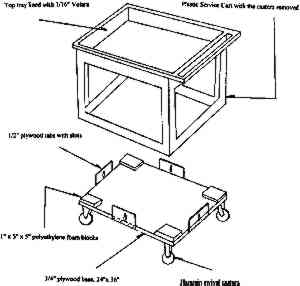SMOOTH MOVES: SUGGESTIONS FOR OBJECT TRANSPORT AND STORAGE EQUIPMENT
PAUL S. STORCH
2 MODIFIED SERVICE CART
The plans for vibration-mitigation alterations to a commercial molded-rubber service cart (fig. 1) were developed by Frank Paraday, a fabricator in the Exhibits Mount Shop. These carts are frequently used for moving small objects of all types and materials by the conservation and museum collections departments. As purchased, the stock wheels on the carts vibrate on all types of floors. The shocks are transmitted directly to the tray surface and into the objects, as observed visually while moving objects from collections to the conservation labs. Utilizing inexpensive materials and the steps outlined below, museum staff can effectively dampen the vibrations to negligible levels. The most significant sign of vibration mitigation, short of instrumental testing, is that the wheels themselves do not oscillate during pushing as did the smaller, harder wheels.
Fig. 1.
Modified commerical service cart for small objects transport. Drawn by Paul S. Storch, adapted from original plans by Frank Paraday
 |
- Remove the stock casters from the cart.
- Attach Hammin Multi-purpose solid rubber casters to the 36 � 24 � � in. plywood base. Use APA-approved plywood that does not contain urea-formaldehyde resin. Two casters are stationary and two are swivel. Attach the swivel casters to the cart end with the handle.
- Attach four � in. plywood vertical tabs with vertical slots cut on center to the sides and ends of the base with wood screws.
- Using clear (EVA) hot-glue sticks, attach a 1 � 5 � 5 in. polyethylene foam block to each corner of the plywood base.
- Set the cart on the padded base. Drill � in. diameter holes in the lower frame of the cart. Secure the padded base to the cart with 1 in. long, � in. diameter lag bolts through the slotted holes in the vertical tabs. Do not overtighten.
- Line the bottom and sides of the top tray of the cart with 1⅙ in. thick Volara foam (Volara A is a crosslinked polyolefin polymeric foam; Volara E is EVA polymeric foam) with adhesive backing (acrylic).
|
